PlanetiQ Radio Occultation: Preliminary Comparative Analysis of Neutral Profiles vs. COSMIC and NWP Models
Abstract
Featured Application
Abstract
1. Introduction
2. Literature Review
Radio Occultation Concept
3. Research Methodology
4. Results and Discussion
4.1. PlanetiQ Observations Spatial and Temporal Distribution
4.2. PlanetiQ-COSMIC Profiles Comparison
4.2.1. Single Profile Comparison
4.2.2. Multi-Profile Comparison
4.3. PlanetiQ-NWP Models Comparison
4.3.1. PlanetiQ-GFS Model Comparison
4.3.2. PlanetiQ-ECMWF Model Comparison
5. Conclusions
Author Contributions
Funding
Institutional Review Board Statement
Informed Consent Statement
Data Availability Statement
Conflicts of Interest
References
- Ghoniem, I.F.; Mousa, A.E.-K.; El-Fiky, G. Optimization of GNSS-RO LEO satellite orbits for Egypt and the Middle East region. Alex. Eng. J. 2020, 59, 389–397. [Google Scholar] [CrossRef]
- PlanetiQ. Technology. PlanetiQ. Available online: https://planetiq.com/technology/ (accessed on 1 February 2024).
- Bai, W.; Deng, N.; Sun, Y.; Du, Q.; Xia, J.; Wang, X.; Meng, X.; Zhao, D.; Liu, C.; Tan, G.; et al. Applications of GNSS-RO to Numerical Weather Prediction and Tropical Cyclone Forecast. Atmosphere 2020, 11, 1204. [Google Scholar] [CrossRef]
- Kursinski, E.R.; Hajj, G.A.; Schofield, J.T.; Linfield, R.P.; Hardy, K.R. Observing Earth’s atmosphere with radio occultation measurements using the Global Positioning System. J. Geophys. Res. Atmos. 1997, 102, 23429–23465. [Google Scholar] [CrossRef]
- Anthes, R.A.; Bernhardt, P.A.; Chen, Y.; Cucurull, L.; Dymond, K.F.; Ector, D.; Healy, S.B.; Ho, S.; Hunt, D.C.; Kuo, Y.; et al. The COSMIC/FORMOSAT-3 Mission: Early Results. Bull. Am. Meteorol. Soc. 2008, 89, 313–334. [Google Scholar] [CrossRef]
- Schreiner, W.S.; Weiss, J.P.; Anthes, R.A.; Braun, J.; Chu, V.; Fong, J.; Hunt, D.; Kuo, Y.-H.; Meehan, T.; Serafino, W.; et al. COSMIC-2 radio occultation constellation: First results. Geophys. Res. Lett. 2020, 47, e2019GL086841. [Google Scholar] [CrossRef]
- Culverwell, I.D.; Healy, S.B.; Elvidge, S. One-dimensional variational ionospheric retrieval using Radio Occultation bending angles: 1. Theory. Space Weather 2024, 22, e2023SW003572. [Google Scholar] [CrossRef]
- Stoffelen, A.; Pailleux, J.; Källén, E.; Vaughan, J.M.; Isaksen, L.; Flamant, P.; Wergen, W.; Andersson, E.; Schyberg, H.; Culoma, A.; et al. The atmospheric dynamics mission for global wind field measurement. Bull. Am. Meteorol. Soc. 2005, 86, 73–88. [Google Scholar] [CrossRef]
- Steiner, A.K.; Ladstädter, F.; Ao, C.O.; Gleisner, H.; Ho, S.-P.; Hunt, D.; Schmidt, T.; Foelsche, U.; Kirchengast, G.; Kuo, Y.-H.; et al. Consistency and structural uncertainty of multi-mission GPS radio occultation records. Atmos. Meas. Tech. 2020, 13, 2547–2575. [Google Scholar] [CrossRef]
- Qiu, C.; Wang, X.; Zhou, K.; Zhang, J.; Chen, Y.; Li, H.; Liu, D.; Yuan, H. Comparative Assessment of Spire and COSMIC-2 Radio Occultation Data Quality. Remote Sens. 2023, 15, 5082. [Google Scholar] [CrossRef]
- Zhang, H.; Huangfu, J.; Wang, X.; Chen, W.; Peng, W.; Tang, Q.; Chu, Y.; Xue, Z. Comparative Analysis of Binhu and Cosmic-2 Radio Occultation Data. Remote Sens. 2022, 14, 4958. [Google Scholar] [CrossRef]
- Ho, S.-P.; Kireev, S.; Shao, X.; Zhou, X.; Jing, X. Processing and Validation of the STAR COSMIC-2 Temperature and Water Vapor Profiles in the Neutral Atmosphere. Remote Sens. 2022, 14, 5588. [Google Scholar] [CrossRef]
- Xu, X.; Luo, J.; Shi, C. Comparison of COSMIC Radio Occultation Refractivity Profiles with Radiosonde Measurements. Adv. Atmos. Sci. 2009, 26, 1137–1145. [Google Scholar] [CrossRef]
- Chen, S.-Y.; Liu, C.-Y.; Huang, C.-Y.; Hsu, S.-C.; Li, H.-W.; Lin, P.-H.; Cheng, J.-P.; Huang, C.-Y. An analysis study of FORMOSAT-7/COSMIC-2 radio occultation data in the troposphere. Remote Sens. 2021, 13, 717. [Google Scholar] [CrossRef]
- Ahmed, I.F.; Abd El-Fatah, M.A.; Mousa, A.E.-K.; El-Fiky, G. Analysis of the differences between GPS radio occultation and radiosonde atmosphere profiles in Egypt. Egypt. J. Remote Sens. Space Sci. 2022, 25, 491–500. [Google Scholar] [CrossRef]
- Melbourne, W.G.; Davis, E.; Duncan, C.; Hajj, G.; Hardy, K.; Kursinski, E.; Meehan, T.K.; Young, L.E.; Yunck, T.P. The Application of Spaceborne GPS to Atmospheric Limb Sounding and Global Change Monitoring; JPL Publication 94-18; NASA/JPL: Pasadena, CA, USA, 1994.
- Rocken, C.; Anthes, R.; Exner, M.; Hunt, D.; Sokolovskiy, S.; Ware, R.; Gorbunov, M.; Schreiner, W.; Feng, D.; Herman, B.; et al. Analysis and validation of GPS/MET data in the neutral atmosphere. J. Geophys. Res. 1997, 102, 29849–29866. [Google Scholar] [CrossRef]
- Mousa, A.; Aoyama, Y.; Tsuda, T. A simulation analysis to optimize orbits for a tropical GPS radio occultation mission. Earth Planets Space 2006, 58, 919–925. [Google Scholar] [CrossRef]
- Fjeldbo, G.; Kliore, J.; Eshleman, V. The neutral atmosphere of Venus as studied with the Mariner V radio occultation experiments. Astron. J. 1971, 76, 123–140. [Google Scholar] [CrossRef]
- Li, M.; Yue, X.; Wan, W.; Schreiner, W. Characterizing Ionospheric Effect on GNSS Radio Occultation Atmospheric Bending Angle. J. Geophys. Res. Space Phys. 2020, 125, e2019JA027471. [Google Scholar] [CrossRef]
- Liu, H.; Zou, X.; Shao, H.; Anthes, R.; Chang, J.; Tseng, J.-H.; Wang, B. Impact of GPS/MET bending angle profiles on assimilation and forecasts for the period June 20–30. J. Geophys. Res. 2001, 106, 31771–31786. [Google Scholar] [CrossRef]
- Prol, F.S.; Hoque, M.M.; Hernández-Pajares, M.; Yuan, L.; Olivares-Pulido, G.; von Engeln, A.; Marquardt, C.; Notarpietro, R. Study of Ionospheric Bending Angle and Scintillation Profiles Derived by GNSS Radio-Occultation with MetOp-A Satellite. Remote Sens. 2023, 15, 1663. [Google Scholar] [CrossRef]
- Shen, Z.; He, Q.; Li, L.; Zhang, K.; Wu, S. Daily Climatological Fields Based on GNSS Radio Occultation Measurements: A Feasibility Study. In China Satellite Navigation Conference (CSNC) 2020 Proceedings: Volume I; Sun, J., Yang, C., Xie, J., Eds.; Springer: Berlin/Heidelberg, Germany, 2020. [Google Scholar] [CrossRef]
- Camacho-Lara, S. Current and Future GNSS and Their Augmentation Systems. In Handbook of Satellite Applications; Pelton, J., Madry, S., Camacho-Lara, S., Eds.; Springer: Berlin/Heidelberg, Germany, 2016. [Google Scholar] [CrossRef]
- Innerkofler, J.; Kirchengast, G.; Schwärz, M.; Marquardt, C.; Andres, Y. GNSS radio occultation excess-phase processing for climate applications including uncertainty estimation. Atmos. Meas. Tech. 2023, 16, 5217–5247. [Google Scholar] [CrossRef]
- Pirscher, B. Multi-Satellite Climatologies of Fundamental Atmospheric Variables from Radio Occultation and Their Validation. Ph.D. Thesis, Wegener Center Verlag Graz, University of Graz (Austria), Graz, Austria, 2010; pp. 33–2010. [Google Scholar]
- Alizadeh, M.; Wijaya, D.; Hobiger, T.; Weber, R.; Schuh, H. Atmospheric Effects in Space Geodesy. In Atmospheric Effects in Space Geodesy; Springer: Berlin/Heidelberg, Germany, 2013. [Google Scholar] [CrossRef]
- Born, M.; Wolf, E. Principles of Optics; Pergamon: New York, NY, USA, 1964. [Google Scholar]
- Xie, F.; Syndergaard, S.; Kursinski, E.R.; Herman, B.M. An approach for retrieving marine boundary layer refractivity from GPS occultation data in the presence of superrefraction. J. Atmos. Ocean. Technol. 2006, 23, 1629–1644. [Google Scholar] [CrossRef]
- University Corporation for Atmospheric Research (UCAR). Available online: https://ucar.edu/ (accessed on 1 February 2024).
- National Oceanic and Atmospheric Administration (NOAA). Available online: https://www.noaa.gov/ (accessed on 1 February 2024).
- European Centre for Medium-Range Weather Forecasts (ECMWF). Available online: https://www.ecmwf.int/ (accessed on 1 February 2024).
- Chang, H.; Lee, J.; Yoon, H.; Morton, Y.; Saltman, A. Performance assessment of radio occultation data from GeoOptics by comparing with COSMIC data. Earth Planets Space 2022, 74, 108. [Google Scholar] [CrossRef]
- Foelsche, U.; Scherllin-Pirscher, B.; Ladstädter, F.; Steiner, A.K.; Kirchengast, G. Refractivity and temperature climate records from multiple radio occultation satellites consistent within 0.05%. Atmos. Meas. Tech. 2011, 4, 2007–2018. [Google Scholar] [CrossRef]
- Veenus, V.; Das, S.S.; Sama, B.; Uma, K.N. A comparison of temperature and relative humidity measurements derived from COSMIC-2 radio occultations with radiosonde observations made over the Asian summer monsoon region. Remote Sens. Lett. 2022, 13, 394–405. [Google Scholar] [CrossRef]
- Anthes, R.; Sjoberg, J.; Rieckh, T.; Wee, T.-K.; Zeng, J. COSMIC-2 radio occultation temperature, specific humidity, and precipitable water in Hurricane Dorian (2019). Terr. Atmos. Ocean. Sci. 2021, 32, 925–938. [Google Scholar] [CrossRef]
- Singh, R.; Ojha, S.; Anthes, R.; Hunt, D. Evaluation and Assimilation of the COSMIC-2 Radio Occultation Constellation Observed Atmospheric Refractivity in the WRF Data Assimilation System. J. Geophys. Res. Atmos. 2021, 126, e2021JD034935. [Google Scholar] [CrossRef]
- Liao, M.; Zhang, P.; Yang, G.-L.; Bi, Y.-M.; Liu, Y.; Bai, W.-H.; Meng, X.; Du, Q.-F.; Sun, Y.-Q. Preliminary validation of the refractivity from the new radio occultation sounder GNOS/FY-3C. Atmos. Meas. Tech. 2016, 9, 781–792. [Google Scholar] [CrossRef]
- Shao, X.; Ho, S.-P.; Zhang, B.; Zhou, X.; Kireev, S.; Chen, Y.; Cao, C. Comparison of COSMIC-2 radio occultation retrievals with RS41 and RS92 radiosonde humidity and temperature measurements. Terr. Atmos. Ocean. Sci. 2021, 32, 1015–1032. [Google Scholar] [CrossRef]
- Gleisner, H.; Lauritsen, K.B.; Nielsen, J.K.; Syndergaard, S. Evaluation of the 15-year ROM SAF monthly mean GPS radio occultation climate data record. Atmos. Meas. Tech. 2020, 13, 3081–3098. [Google Scholar] [CrossRef]

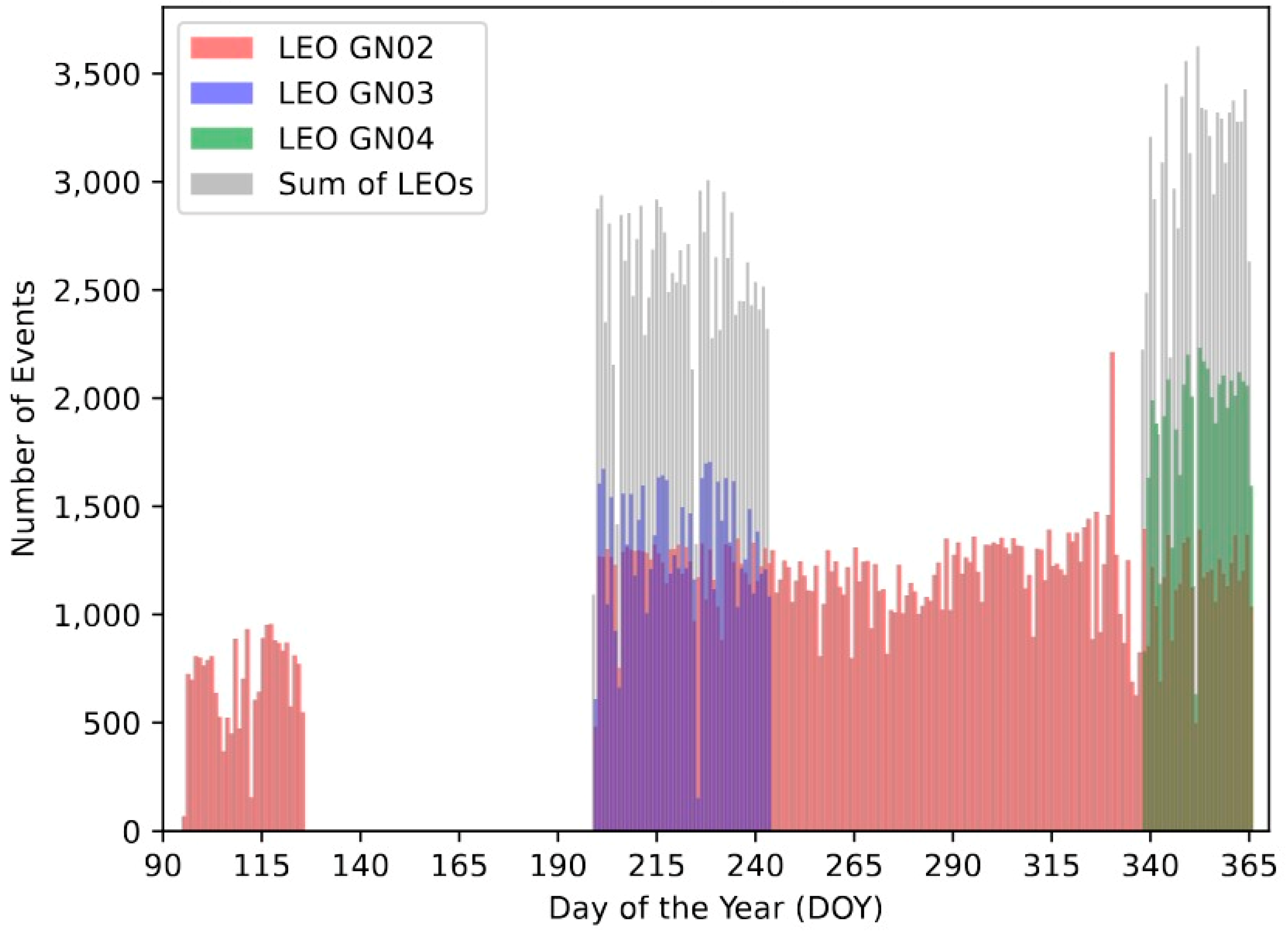
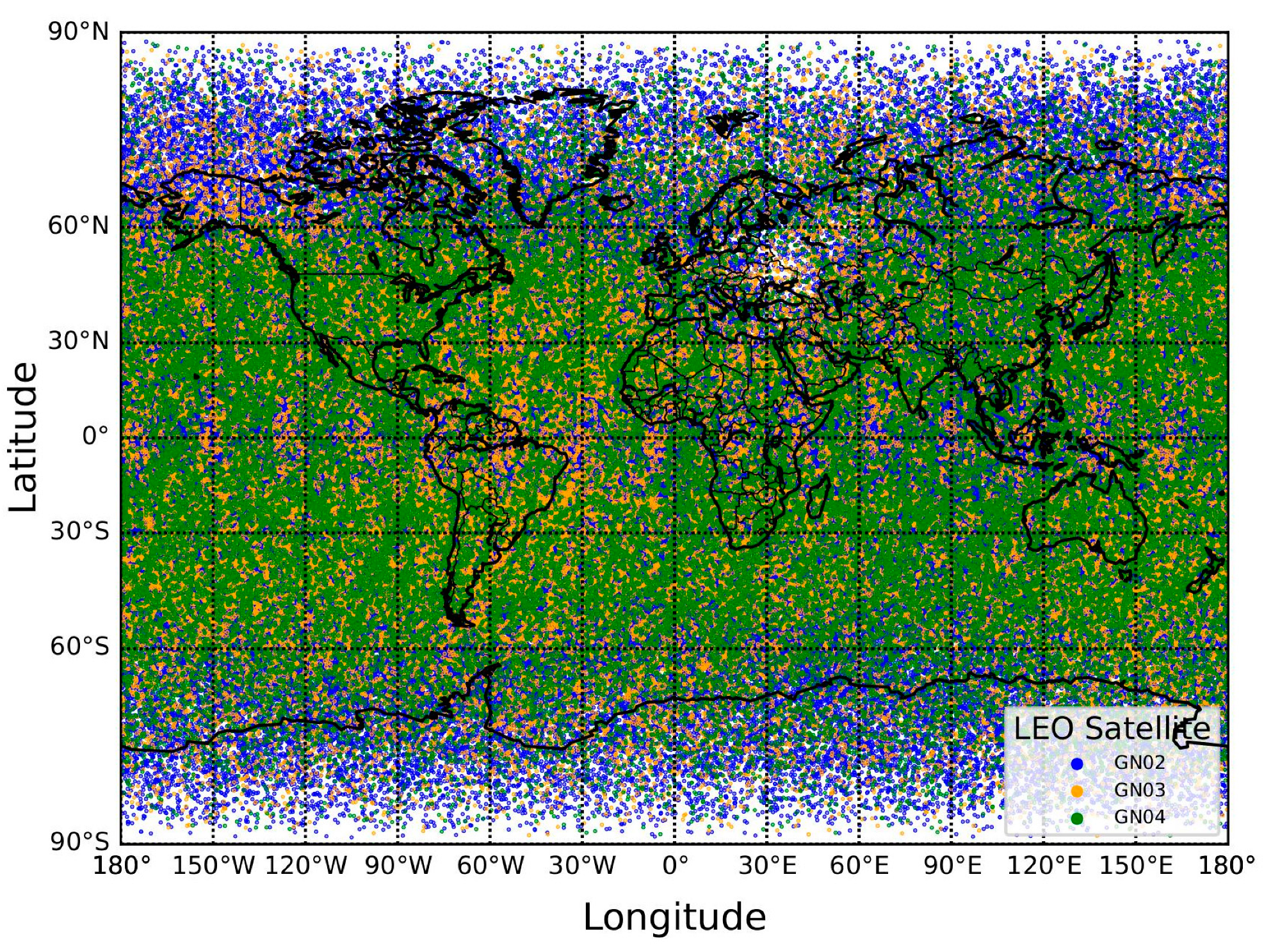


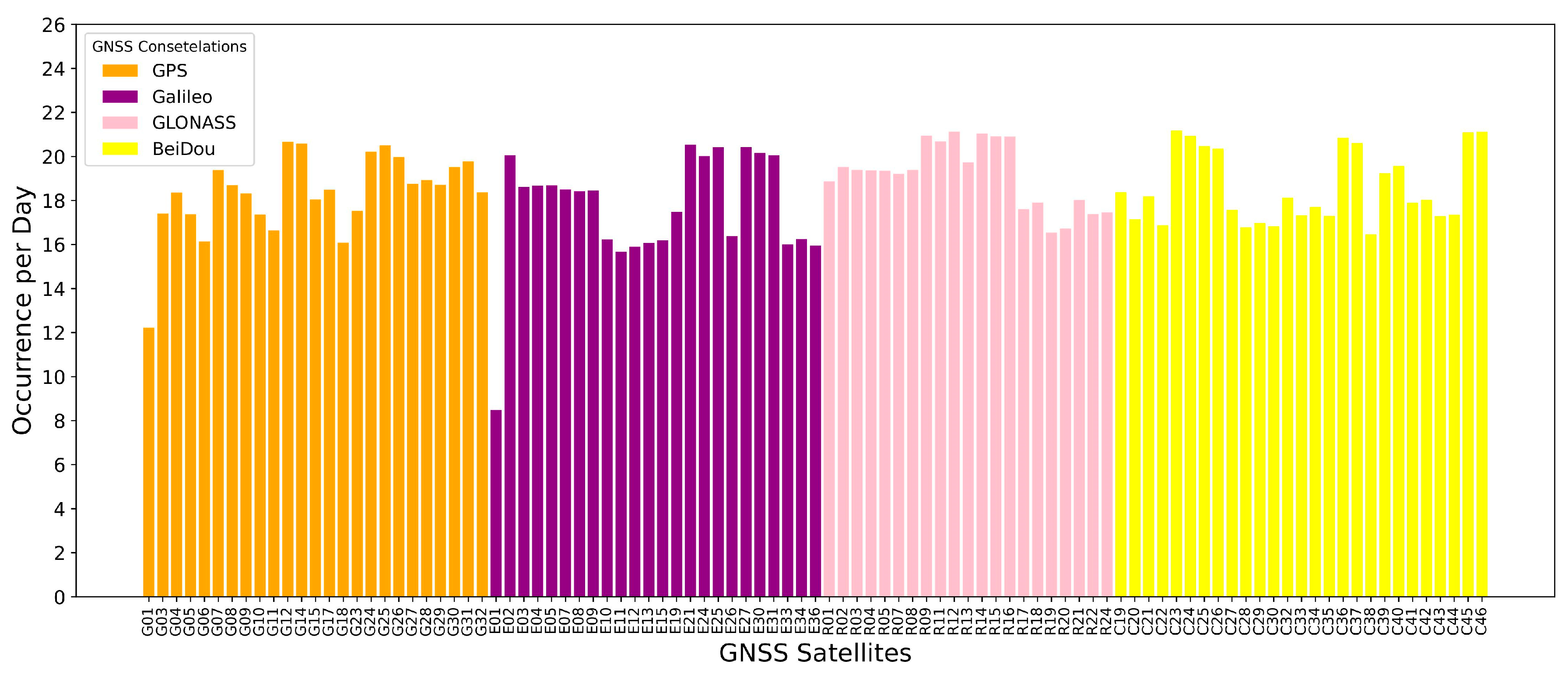
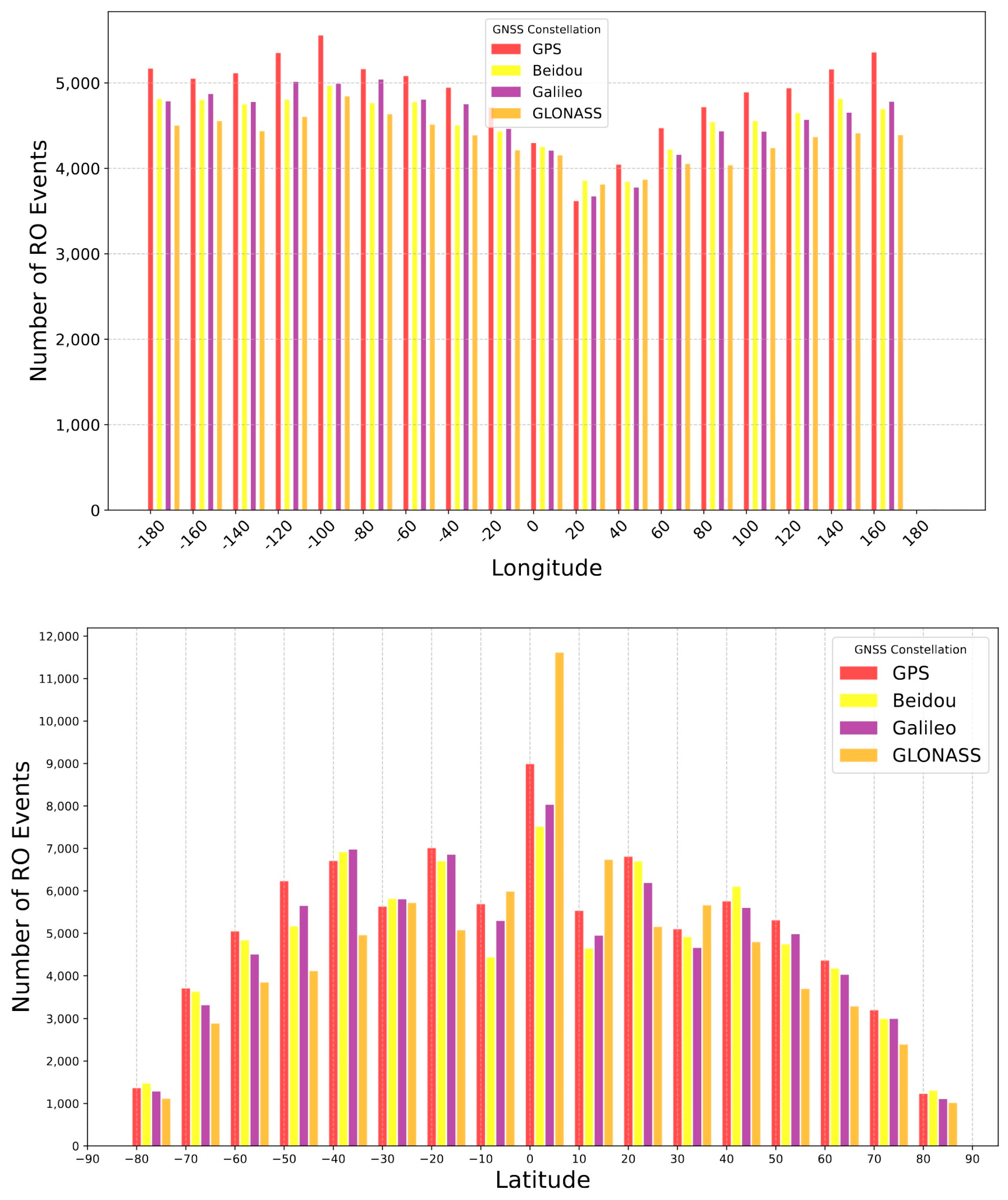


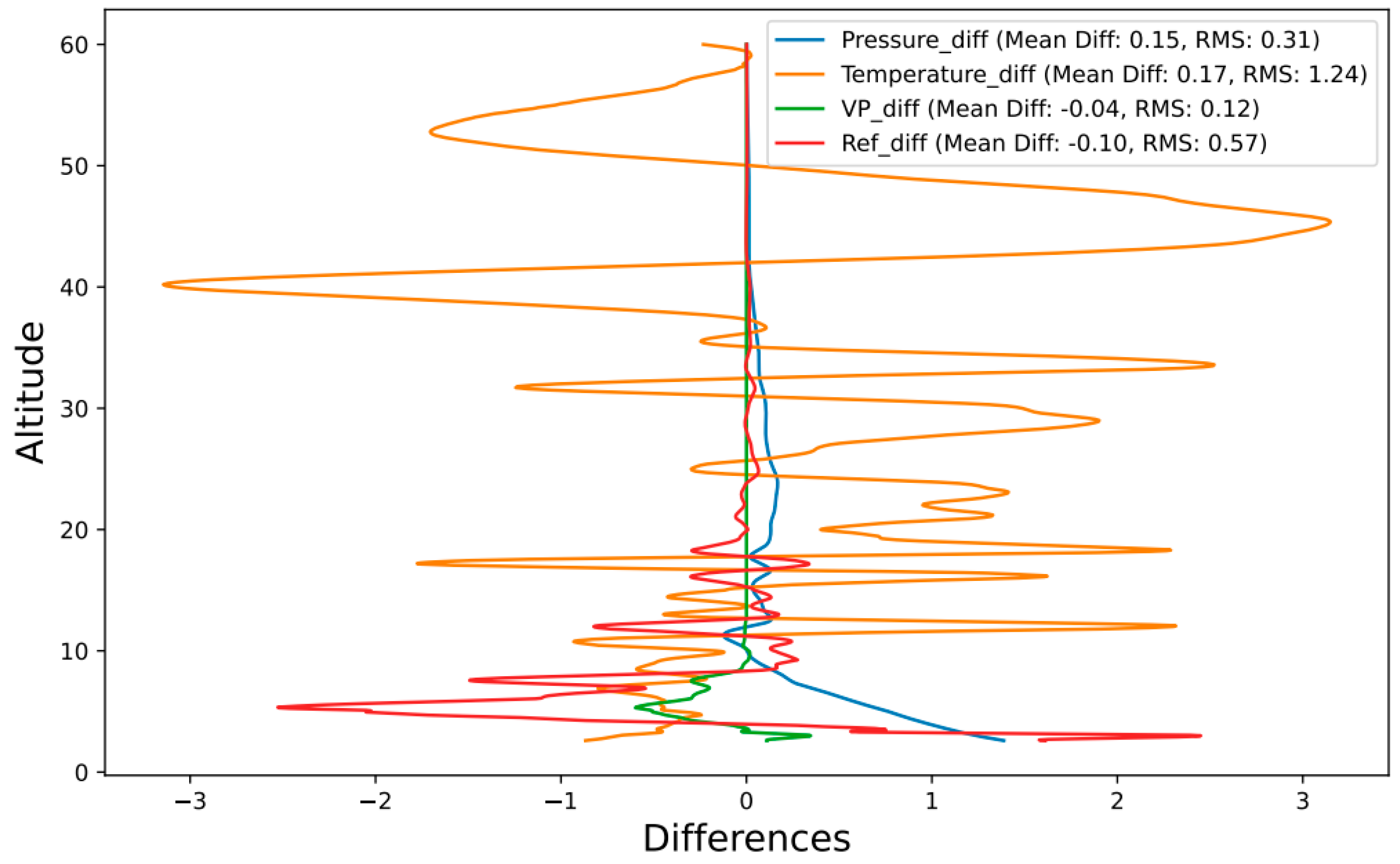
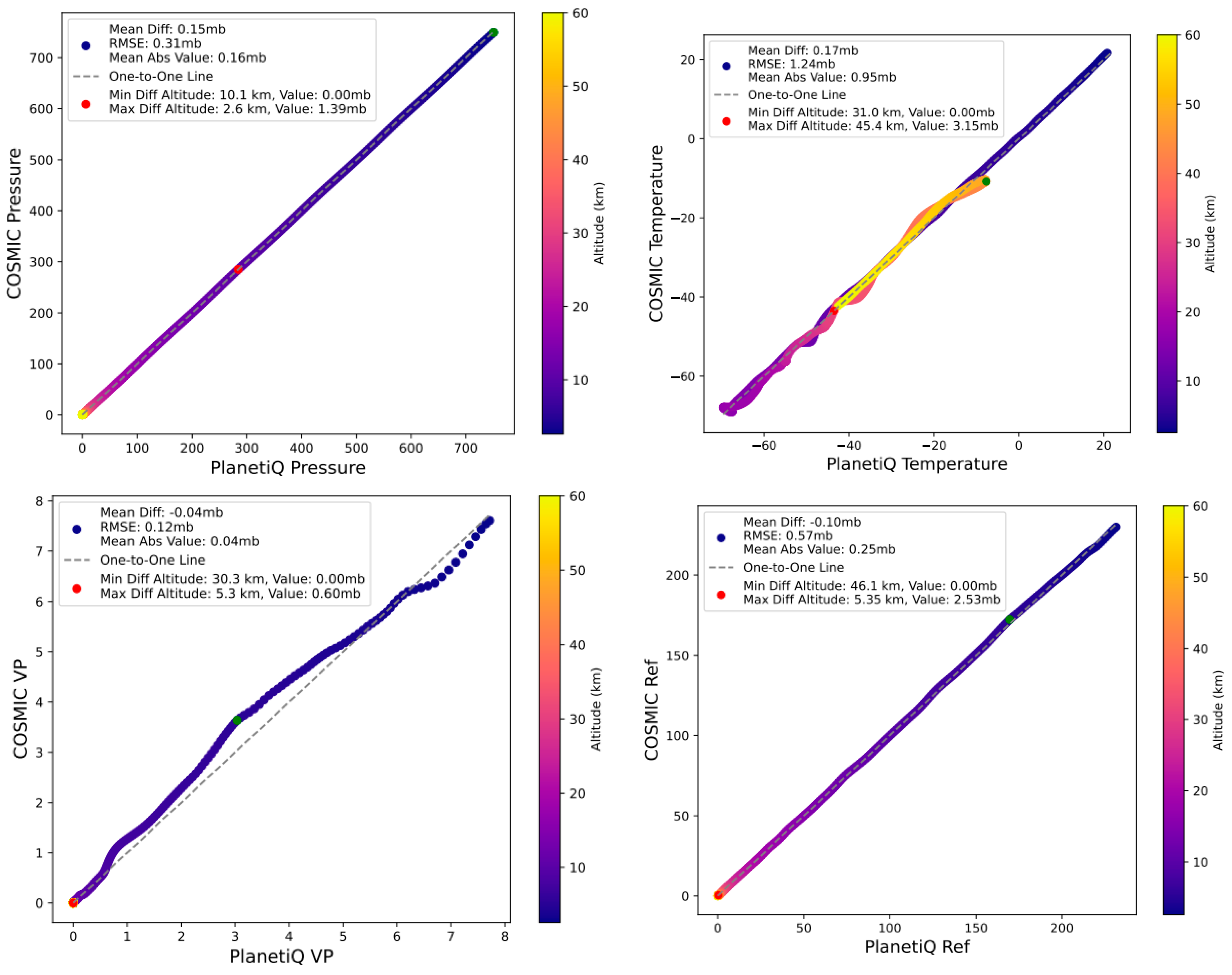
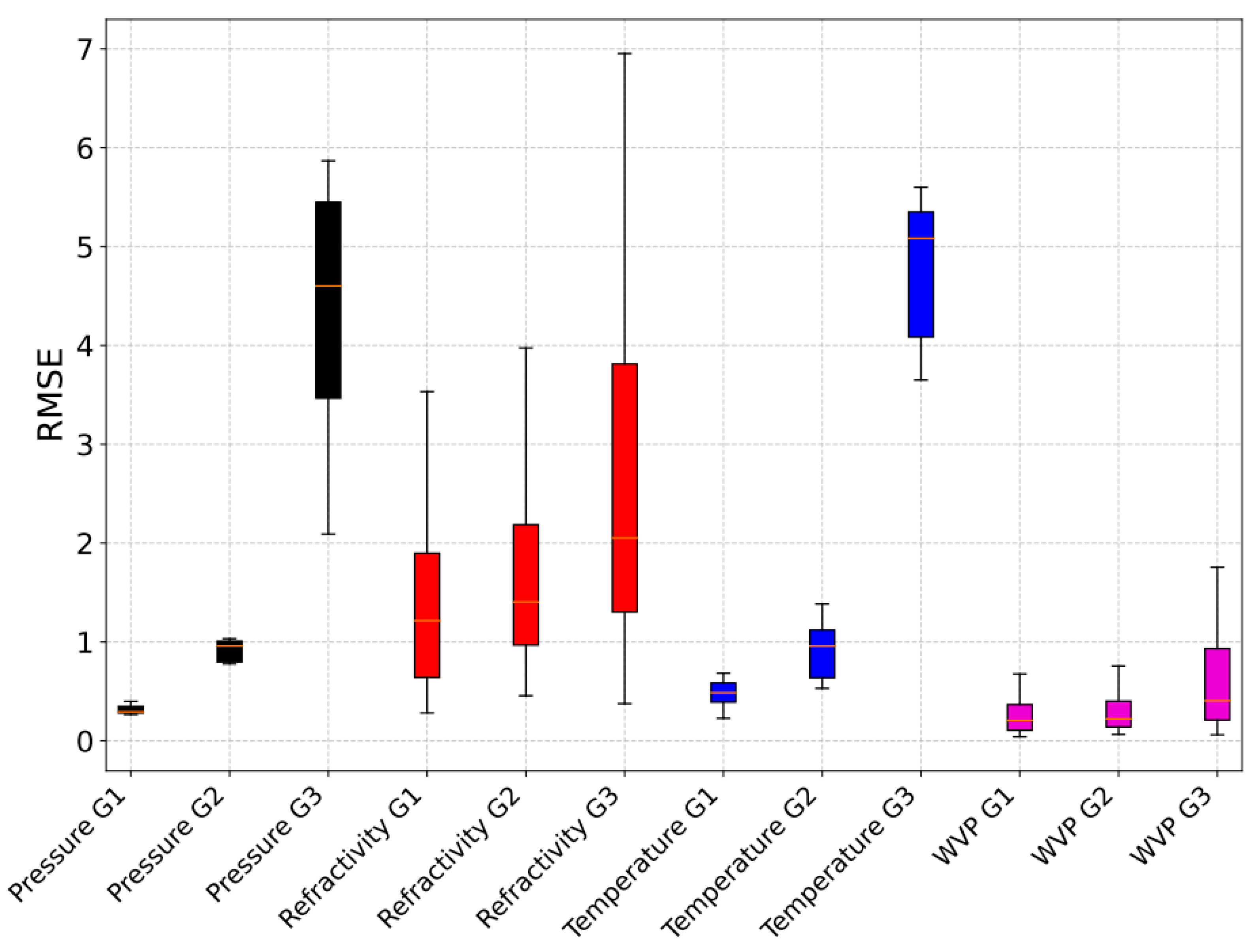
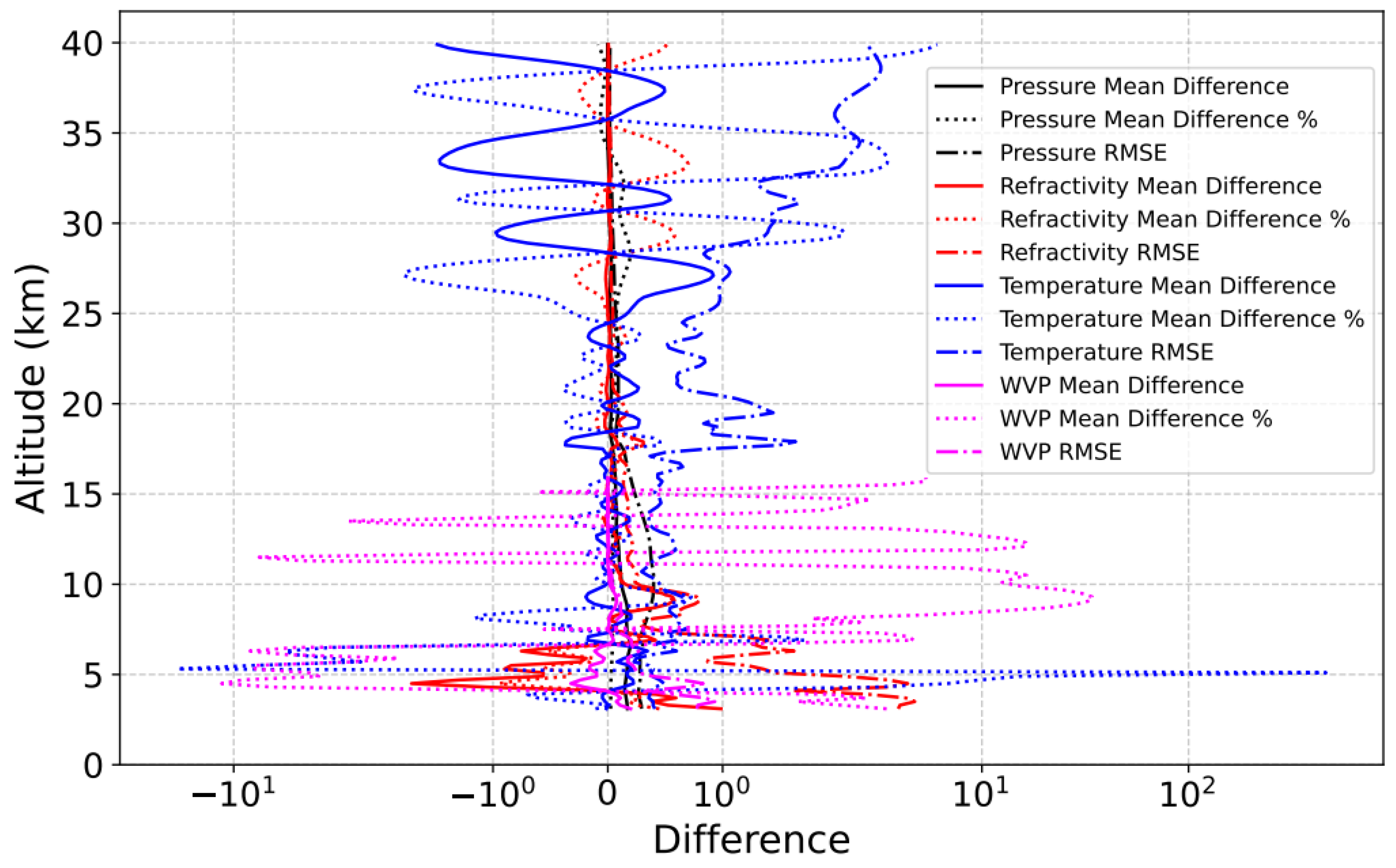
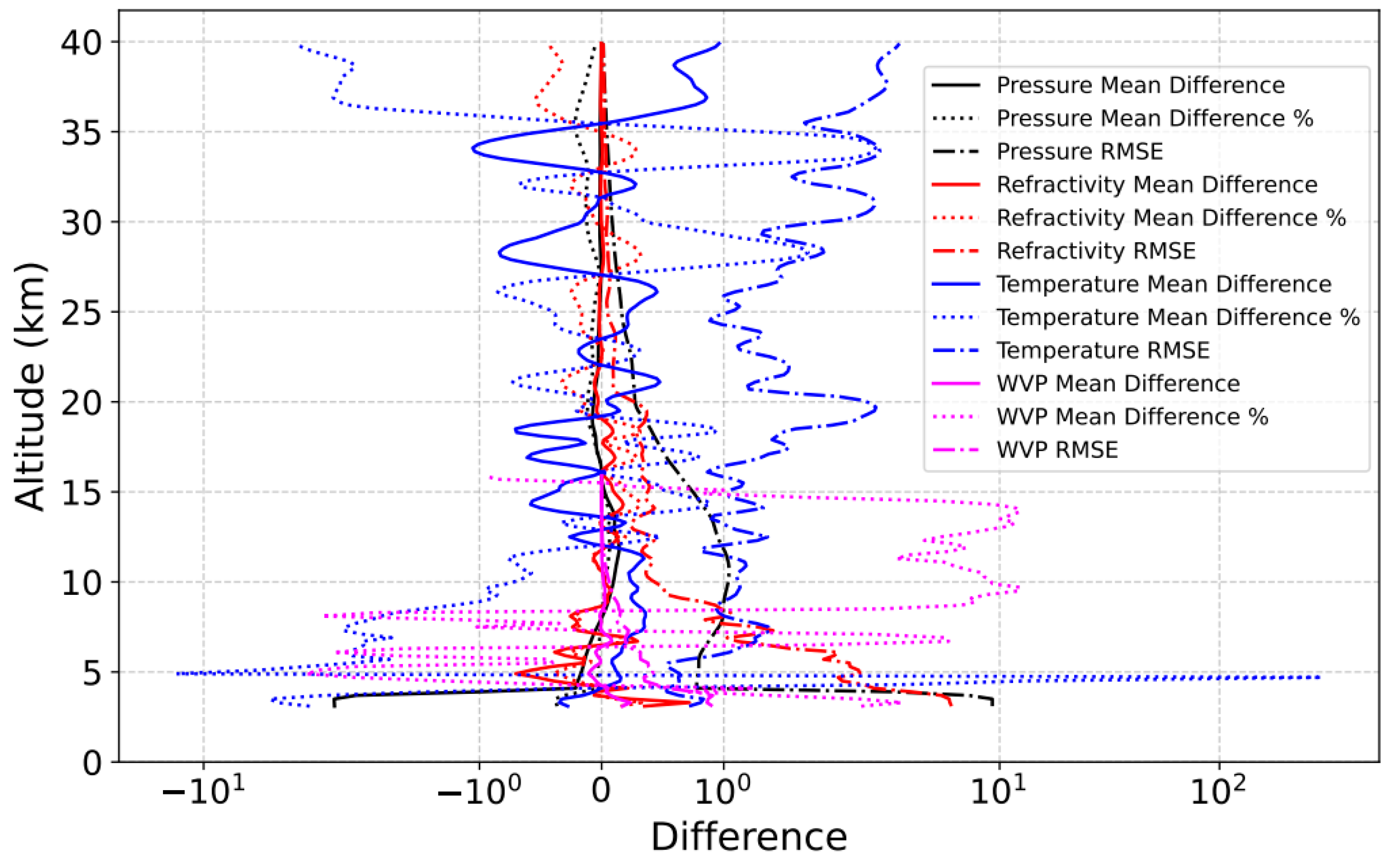
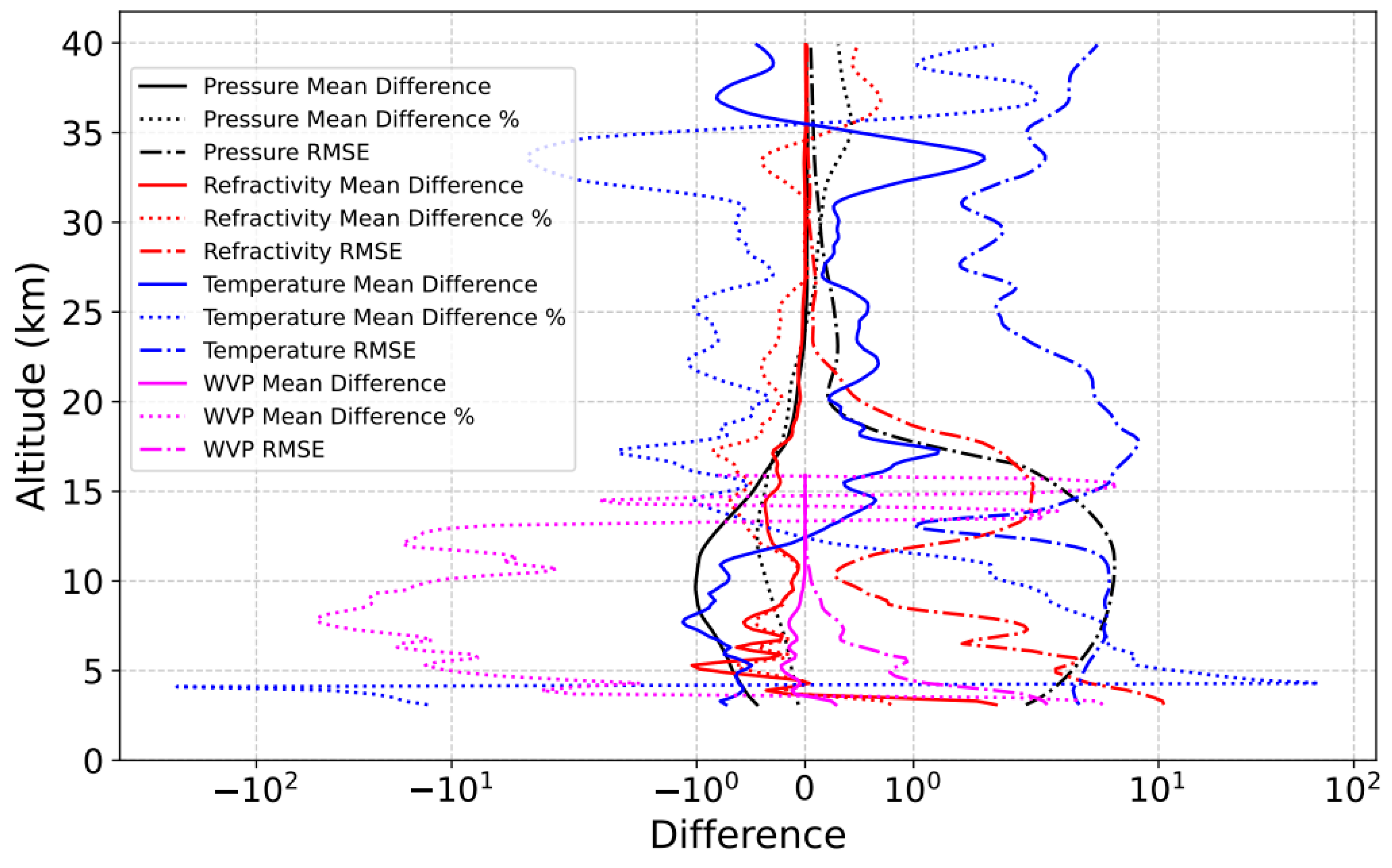
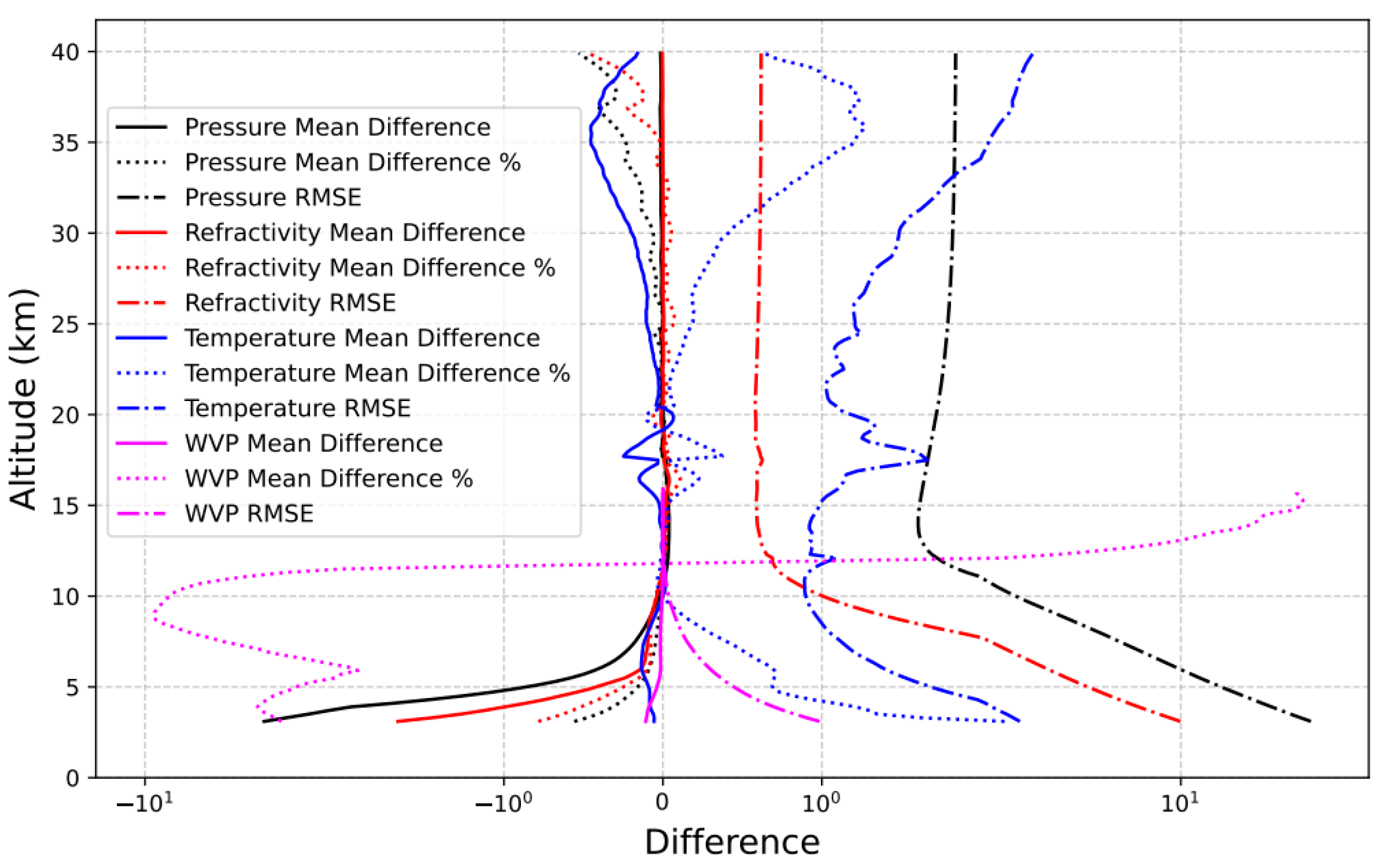
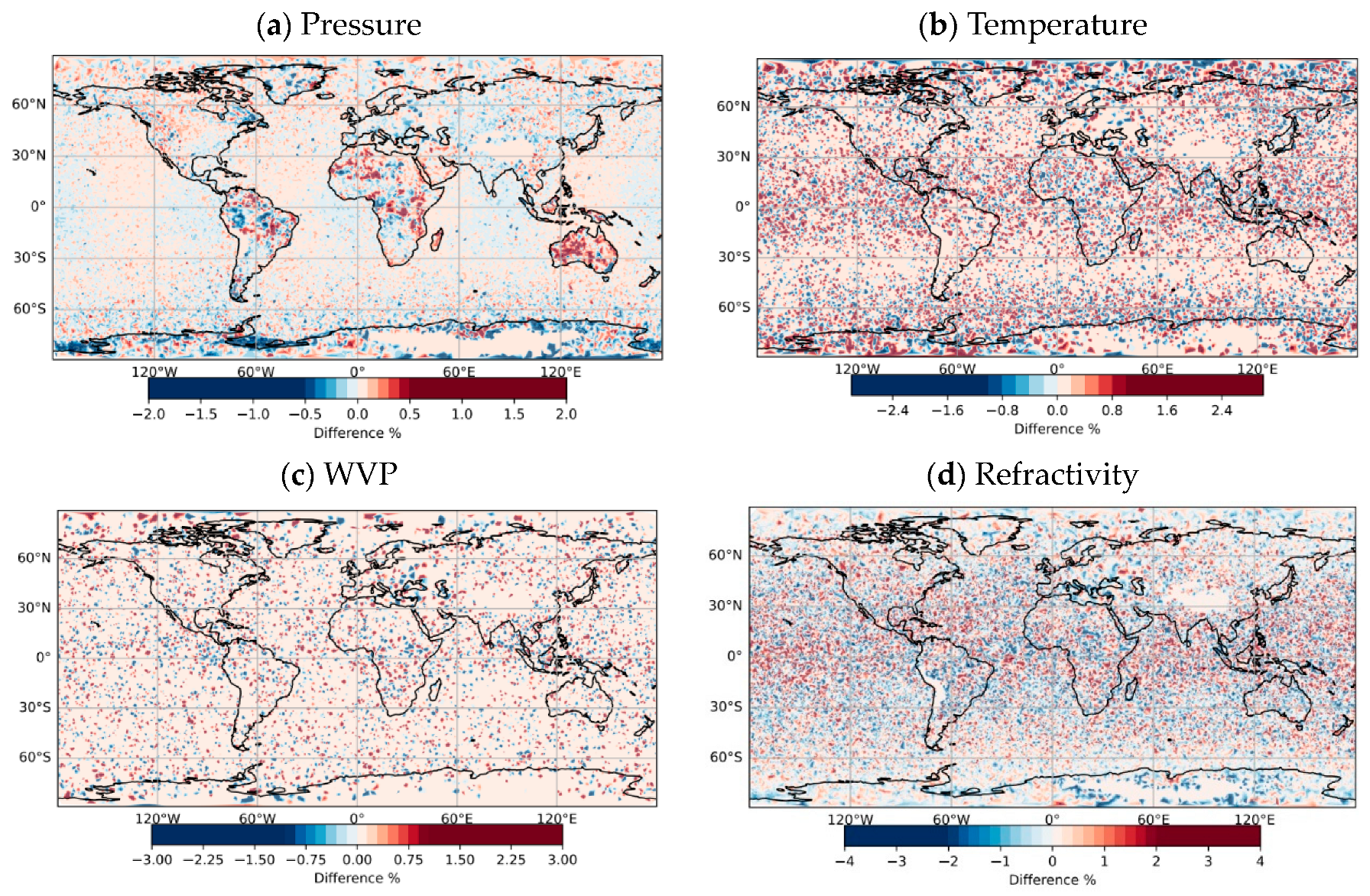
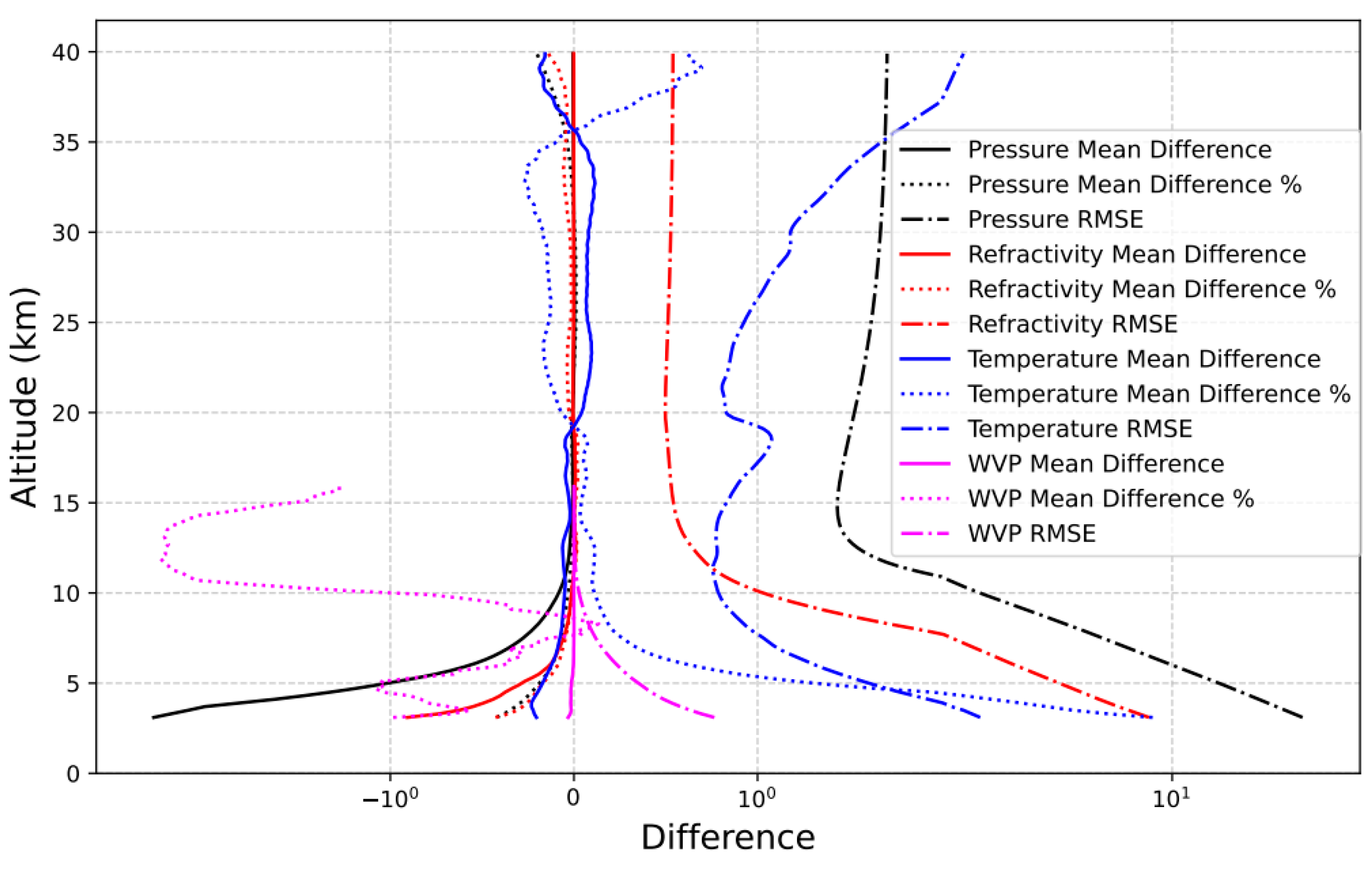
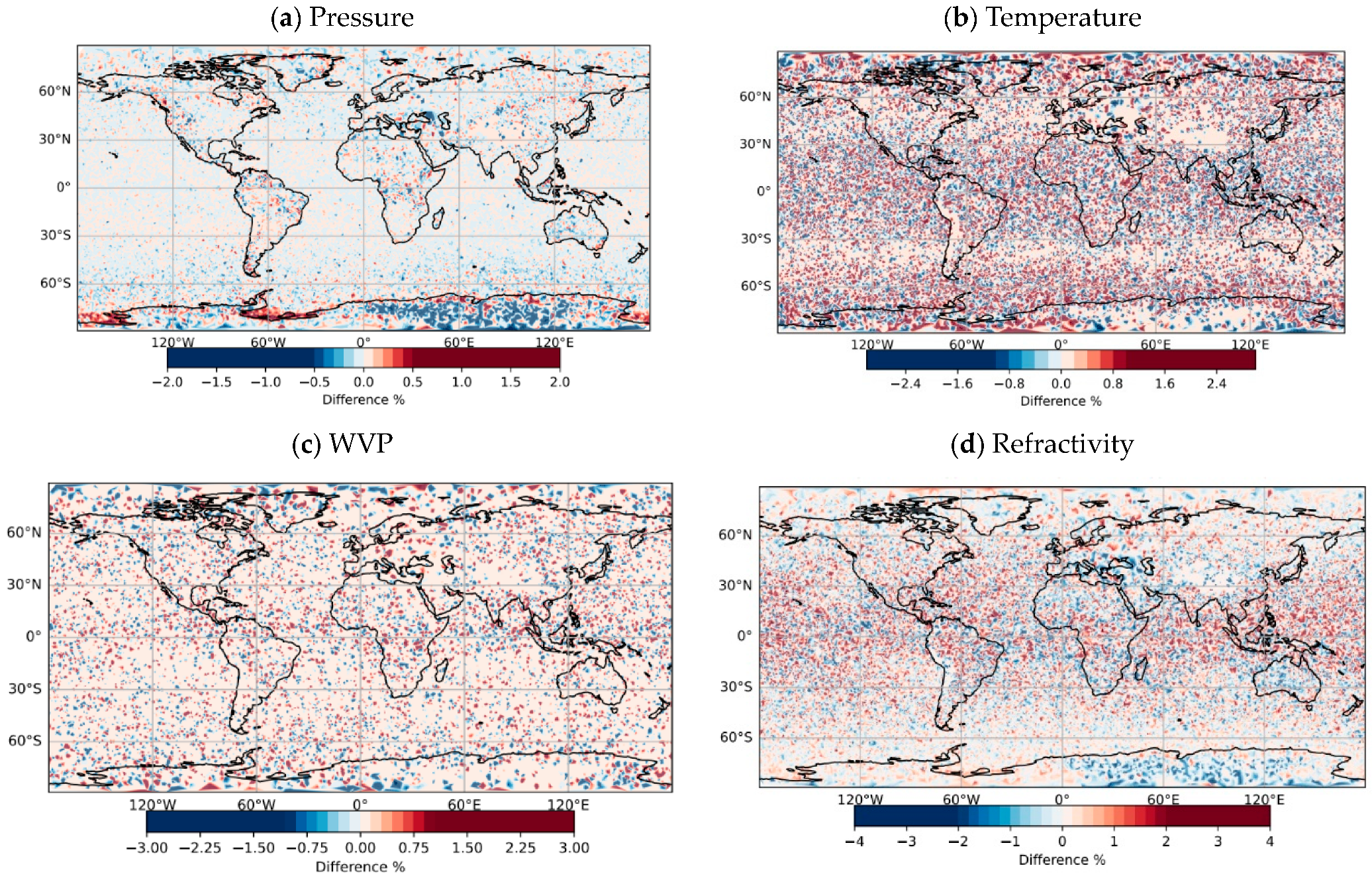

| PlanetiQ Observations (Filestamp) | COSMIC Observations (Filestamp) | f-Test p Value (Pres., Temp., WVP, Ref.) | T-Stat (Pres., Temp., WVP, Ref.) | T-cr. |
|---|---|---|---|---|
| GN04.2023.353.18.15.R24 | C2E2.2023.353.18.18.G31 | 0.99, 0.8, 0.45, 0.88 | 0.008, 0.24, −0.75, −0.15 | 1.96 |
| GN02.2023.347.21.41.C20 | C2E1.2023.347.21.39.G31 | 0.99, 0.87, 0.91, 0.97 | 0.003, 0.16, −0.11, −0.03 | |
| GN04.2023.348.08.07.C24 | C2E6.2023.348.08.10.G05 | 0.98, 0.8, 0.29, 0.92 | 0.016, 0.25, 1.07, 0.1 | |
| GN04.2023.340.11.18.G23 | C2E5.2023.340.11.13.R17 | 0.75, 0.73, 0.52, 0.71 | −0.31, −0.33, −0.63, −0.37 | |
| GN04.2023.353.10.22.G07 | C2E2.2023.353.10.22.G07 | 0.99, 0.99, 0.87, 0.99 | −0.01, −0.02, −0.16, −0.02 | |
| GN02.2023.340.06.33.C41 | C2E3.2023.340.06.28.G24 | 0.99, 0.94, 0.73, 0.94 | 0.00, 0.08, 0.35, 0.08 | |
| GN04.2023.348.08.07.E31 | C2E6.2023.348.08.10.G05 | 0.98, 0.84, 0.53, 0.96 | 0.02, 0.2, 0.62, 0.06 | |
| GN04.2023.340.11.18.R17 | C2E5.2023.340.11.13.R17 | 0.99, 0.89, 0.93, 0.98 | 0.00, −0.13, −0.08, 0.02 | |
| GN02.2023.342.14.23.G18 | C2E6.2023.342.14.32.R16 | 0.99, 0.98, 0.75, 0.93 | 0.00, 0.03, 0.31, 0.08 |
| PlanetiQ Observations (Filestamp) | Model | f-Test p Value (Pres., Temp., WVP, Ref.) | T-Stat (Pres., Temp., WVP, Ref.) | T-cr. |
|---|---|---|---|---|
| GN02.2023.100.00.10.R20 | GFS ECMWF | 0.98, 0.4, 0.00, 0.98 0.96, 0.17, 0.00, 0.94 | −0.015, 0.82, 8.4, −0.02 −0.05, 0.01, 8.4, −0.08 | 1.96 |
| GN02.2023.125.00.44.E11 | GFS ECMWF | 0.98, 0.87, 0.6, 0.99 0.99, 0.95, 0.66, 0.99 | 0.03, −0.16, −0.51, 0.01 0.02, −0.07, −0.45, −0.01 | |
| GN03.2023.200.12.47.G27 | GFS ECMWF | 0.9, 0.98, 0.33, 0.89 0.95, 0.99, 0.87, 0.93 | −0.12, 0.02, 0.98, −0.135 0.05, −0.02, 0.17, 0.08 | |
| GN02.2023.250.00.04.G12 | GFS ECMWF | 1, 0.92, 0.18, 0.99 0.99, 1, 0.52, 0.99 | 0.00, −0.1, −1.33, 0.01 −0.01, 0.00, 0.64, 0.01 | |
| GN02.2023.300.00.25.E09 | GFS ECMWF | 0.93, 0.58, 0.09, 0.88 0.93, 0.69, 0.62, 0.92 | 0.09, −0.54, 1.7, 0.02 0.08, −0.39, 0.49, 0.1 | |
| GN02.2023.350.01.00.C44 | GFS ECMWF | 0.99, 0.92, 0.87, 0.95 0.97, 0.93, 0.87, 0.93 | 0.01, 0.01, 0.15, 0.05 0.02, −0.02, 0.17, 0.06 |
Disclaimer/Publisher’s Note: The statements, opinions and data contained in all publications are solely those of the individual author(s) and contributor(s) and not of MDPI and/or the editor(s). MDPI and/or the editor(s) disclaim responsibility for any injury to people or property resulting from any ideas, methods, instructions or products referred to in the content. |
© 2024 by the authors. Licensee MDPI, Basel, Switzerland. This article is an open access article distributed under the terms and conditions of the Creative Commons Attribution (CC BY) license (https://creativecommons.org/licenses/by/4.0/).
Share and Cite
Ahmed, I.F.; Alheyf, M.; Yamany, M.S. PlanetiQ Radio Occultation: Preliminary Comparative Analysis of Neutral Profiles vs. COSMIC and NWP Models. Appl. Sci. 2024, 14, 4179. https://doi.org/10.3390/app14104179
Ahmed IF, Alheyf M, Yamany MS. PlanetiQ Radio Occultation: Preliminary Comparative Analysis of Neutral Profiles vs. COSMIC and NWP Models. Applied Sciences. 2024; 14(10):4179. https://doi.org/10.3390/app14104179
Chicago/Turabian StyleAhmed, Ibrahim F., Mohammed Alheyf, and Mohamed S. Yamany. 2024. "PlanetiQ Radio Occultation: Preliminary Comparative Analysis of Neutral Profiles vs. COSMIC and NWP Models" Applied Sciences 14, no. 10: 4179. https://doi.org/10.3390/app14104179
APA StyleAhmed, I. F., Alheyf, M., & Yamany, M. S. (2024). PlanetiQ Radio Occultation: Preliminary Comparative Analysis of Neutral Profiles vs. COSMIC and NWP Models. Applied Sciences, 14(10), 4179. https://doi.org/10.3390/app14104179








